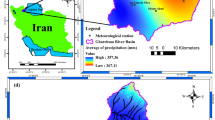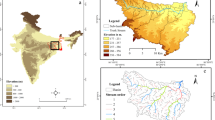Abstract
Information entropy is an effective method to analyze uncertainty in various processes. The principle of maximum entropy (POME) provides a guide line for the parameter estimation of probability density function (PDF). Mutual entropy analysis is well qualified for delineating the nonlinear and complex multivariable relationship. The probability distribution of model output is the element of model uncertainty analysis. In this paper, a synthetic groundwater flow field is build to produce groundwater level series (GLS). The probability distribution of GLS is obtained by the frequency analysis method based on POME and Chi-Squared test. The important uncertainty factors that affect the parameters of PDF of GLS are assessed by the sensitivity analysis methods, which include stepwise regression analysis and mutual entropy analysis. Results of this analysis indicate that most of the GLS follow normal distribution (or log-normal distribution), while a few obey others. The mean and variance of normal GLS are affected differently by the input variables of groundwater model. Mutual entropy analysis is more competitive and appropriate for delineating the nonlinear and nonmonotonic multivariable relationship than stepwise regression analysis.




Similar content being viewed by others
References
Ajami NK, Hornberger GM, Sunding DL (2008) Sustainable water resource management under hydrological uncertainty. Water Resour Res 44(11):W11406. doi:10.1029/2007wr006736
Bergante S, Facciotto G, Minotta G (2010) Identification of the main site factors and management intensity affecting the establishment of Short-Rotation-Coppices (SRC) in Northern Italy through stepwise regression analysis. Cent Eur J Biol 5(4):522–530
Beven K, Binley A (1992) The Future of distributed models—model calibration and uncertainty prediction. Hydrol Process 6(3):279–298
Beven K, Freer J (2001) Equifinality, data assimilation, and uncertainty estimation in mechanistic modelling of complex environmental systems using the GLUE methodology. J Hydrol 249(1–4):11–29
Chen YF, Hou Y, Van Gelder P, Zhigui S (2002) Study of parameter estimation methods for Pearson-III distribution in flood frequency analysis. Iahs-Aish 271:263–269
Feyen L, Caers J (2006) Quantifying geological uncertainty for flow and transport modeling in multi-modal heterogeneous formations. Adv Water Resour 29(6):912–929
Feyen L, Ribeiro PJ, De Smedt F, Diggle PJ (2003) Stochastic delineation of capture zones: classical versus Bayesian approach. J Hydrol 281(4):313–324
Fu JL, Gomez-Hernandez JJ (2009) Uncertainty assessment and data worth in groundwater flow and mass transport modeling using a blocking Markov chain Monte Carlo method. J Hydrol 364(3–4):328–341
Ghaffarian H, Parvin H, Minaei B (2009) A new approach in feature subset selection based on fuzzy entropy concept. 2009 14th international computer conference: 60–64
Harbaugh AW (2005) The U.S. geological survey modular ground-water model–the ground-water flow process: U.S. geological survey techniques and methods 6-A16
Hassan AE, Bekhit HM, Chapman JB (2008) Uncertainty assessment of a stochastic groundwater flow model using GLUE analysis. J Hydrol 362(1–2):89–109
Hassan AE, Bekhit HM, Chapman JB (2009) Using Markov Chain Monte Carlo to quantify parameter uncertainty and its effect on predictions of a groundwater flow model. Environ Modell Softw 24(6):749–763
Haussler D, Opper M (1997) Mutual, information, metric entropy and cumulative relative entropy risk. Ann Stat 25(6):2451–2492
Jaynes ET (1957) Information theory and statistical mechanics. 2. Phys Rev 108(2):171–190
Koundouri P (2004) Current issues in the economics of groundwater resource management. J Econ Surv 18(5):703–740
Kumar PTK, Sekimoto H (2009) Reduction of systematic uncertainty in the transmission measurement of iron using entropy based mutual information. Radiat Meas 44(2):168–172
Liang J, Zeng GM, Guo SL, et al (2009) Uncertainty analysis of stochastic solute transport in a heterogeneous aquifer. Environ Eng Sci 26(2):359–368
Mishra S, Deeds NE, RamaRao BS (2003) Application of classification trees in the sensitivity analysis of probabilistic model results. Reliab Eng Syst Safe 79(2):123–129
Mishra S, Deeds N, Ruskauff G (2009) Global sensitivity analysis techniques for probabilistic ground water modeling. Ground Water 47(5):730–747
Moddemeijer R (1989) On estimation of entropy and mutual information of continuous distributions. Signal Process 16(3):233–248
Modis K, Vatalis K, Papantonopoulos G, Sachanidis C (2010) Uncertainty management of a hydrogeological data set in a Greek lignite basin, using BME. Stoch Env Res Risk A 24(1):47–56
Onoz B, Bayazit M (1995) Best-fit distributions of largest available flood samples. J Hydrol 167(1–4):195–208
Pappenberger F, Beven KJ, Ratto M, Matgen P (2008) Multi-method global sensitivity analysis of flood inundation models. Adv Water Resour 31(1):1–14
Robin MJL, Gutjahr AL, Sudicky EA, Wilson JL (1993) Cross-correlated random-field generation with the direct fourier-transform method. Water Resour Res 29(7):2385–2397
Robinson DW (2008) Entropy and uncertainty. Entropy 10(4):493–506
Rojas R, Feyen L, Dassargues A (2009) Sensitivity analysis of prior model probabilities and the value of prior knowledge in the assessment of conceptual model uncertainty in groundwater modelling. Hydrol Process 23(8):1131–1146
Rojas R, Feyen L, Batelaan O, Dassargues A (2010) On the value of conditioning data to reduce conceptual model uncertainty in groundwater modeling. Water Resour Res 46:W08520. doi:10.1029/2009WR008822
Ross SM (2004) Introduction to probability and statistics for engineers and scientists. Elsevier Academic Press, San Diego, CA
Serre ML, Christakos G, Li H, Miller CT (2003) A BME solution of the inverse problem for saturated groundwater flow. Stoch Env Res Risk A 17(6):354–369
Shannon CE (1948) A mathematical theory of communication. Bell Syst Techn J 27(3):379–423
Singh VP (1987) Derivation of the Pearson Type (PT) III distribution by using the principle of maximum-entropy (POME)-reply. J Hydrol 90(3–4):355–357
Singh VP (1997) The use of entropy in hydrology and water resources. Hydrol Process 11(6):587–626
Singh VP, Singh K (1985a) Derivation of the gamma-distribution by using the principle of maximum-entropy (POME). Water Resour Bull 21(6):941–952
Singh VP, Singh K (1985b) Derivation of the Pearson Type (PT) III distribution by using the principle of maximum-entropy (POME). J Hydrol 80(3–4):197–214
Singh A, Mishra S, Ruskauff G (2010) Model averaging techniques for quantifying conceptual model uncertainty. Ground Water 48(5):701–715
Sun CX, Zheng SQ (2006) Some Results of parameter estimator based on uniform distribution. College Mathematic 22(5):130–134 (in Chinese with English Abstract)
Tsai FTC (2010) Bayesian model averaging assessment on groundwater management under model structure uncertainty. Stoch Env Res Risk A 24(6):845–861
Wang D, Singh VP, Zhu YS (2007) Hybrid fuzzy and optimal modeling for water quality evaluation. Water Resour Res 43: W05415 (5)
Wang D, Singh VP, Zhu YS, Wu JC (2009) Stochastic observation error and uncertainty in water quality evaluation. Adv Water Resour 32(10):1526–1534
Woodbury A, Sudicky E, Ulrych TJ, Ludwig R (1998) Three-dimensional plume source reconstruction using minimum relative entropy inversion. J Contam Hydrol 32(1–2):131–158
Zhang DP, Luo YL (2000) Applied probability and statistic. Higher Education Press, BeiJing (in Chinese)
Acknowledgments
This study was supported by the National Natural Science Fund of China (No. 41172207, 41071018, 41030746, 40725010, and 40730635), Water Resources Public-welfare Project (No. 200701024), the Skeleton Young Teachers Program and Excellent Disciplines Leaders in Midlife-Youth Program of Nanjing University.
Author information
Authors and Affiliations
Corresponding authors
Appendix: Methods for parameters estimation
Appendix: Methods for parameters estimation
Supposing a number of samples X = (x 1, x 2, …, x n ), n is the length of sample series.
1.1 Normal distribution
The probability density function (PDF) of normal distribution can be expressed as:
The parameters can be estimated by:
E[x], Var[x] are mean and variance of samples.
1.2 Gamma-2 distribution
The PDF of gamma-2 distribution is given as:
where α is shape parameter, β is scale parameter. When the parameters are estimated by traditional moment method, α and β can be expressed as follows:
The parameters are estimated as the function of the second moment of samples, and the estimation error cannot be ignored if the length of data series is not long enough. According to the principle of maximum entropy (POME), the equation of constrains can be written in the following form (Singh and Singh 1985a):
And the parameters are estimated by following equations:
1.3 P-III distribution
The PDF of p-III distribution can be expressed as:
where α is shape parameter, β is scale parameter, c is location parameter. When the parameters are estimated by traditional moment method, the parameters can be given by:
C s is skewness coefficient, C v is deviation coefficient. Hereinto, the C v is the third order moment of samples, a large estimation error will be inevitable if the length of data series is not long enough. Based on POME, the equation of constrains can be written in the following form (Singh and Singh 1985b; Singh 1987):
Based on Eq. 17, a formula can be derived as:
After that, Usually, the curve-fitting method (Chen et al. 2002) is adopted to solve the Eqs. 16,18.
1.4 Uniform distribution
The PDF of uniform distribution can be expressed as:
The parameters can be estimated by (Sun and Zheng 2006):
Rights and permissions
About this article
Cite this article
Zeng, X., Wang, D. & Wu, J. Sensitivity analysis of the probability distribution of groundwater level series based on information entropy. Stoch Environ Res Risk Assess 26, 345–356 (2012). https://doi.org/10.1007/s00477-012-0556-2
Published:
Issue Date:
DOI: https://doi.org/10.1007/s00477-012-0556-2




